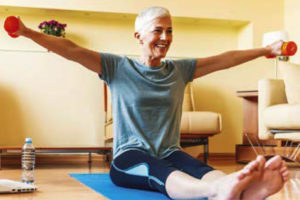How Seniors Can Approach Exercise

Exercise is a vital component of
a healthy lifestyle. By making
exercise part of their day-to-day
routines, people of all ages, including men
and women over the age of 50, can greatly
improve their overall health.
Frequency of exercise
Seniors, particularly those who have not
exercised much in the past, may not know
how much exercise they need to reap the full
rewards of physical activity. Though it’s best
to discuss exercise with a physician prior to
beginning a new regimen, various public
health agencies advise seniors to get at
least 2.5 hours of moderate aerobic exercise
each week. Brisk walking is one example
of moderate aerobic exercise. Seniors who
want to sweat a little more when exercising
can replace moderate aerobic exercise
with one hour and 15 minutes of vigorous
exercise, such as jogging, each week.
Is strength training safe for seniors?
The CDC advises seniors to incorporate
muscle-strengthening activities into their
weekly fitness routines twice per week.
Lifting waits, working with resistance bands,
heavy gardening, and even some forms
of yoga qualify as muscle-strengthening
activities. Exercises that use your body weight
for resistance, such as sit-ups and pushups,
also can help build strength. Always
speak with a physician before beginning a
muscle-strengthening exercise regimen and,
if possible, work with a personal trainer,
especially if you’re a novice.
When to stop a workout
It’s imperative that seniors recognize
when to stop working out. Exercising
more than is recommended by your doctor
can increase the risk of illness or injury.
In addition, stop exercising if any of the
following symptoms appear:
· Dizziness or shortness of breath
· Chest pain or pressure
· Swollen joints
· Nausea
· Tightness in muscles or joints
· Pain anywhere in the body
· Throbbing or burning sensations
Exercise can help seniors stay healthy and
feel more energetic throughout the day. Before
beginning a new regimen, seniors should
discuss physical activity with their physicians.
